









Settlement. Situated 65 kms away from Dudinka, downstream, on the right banks of the Yenisey. In the summer of 1942 about 200 people (special settlers) were abandoned in this not built-up place, right on the naked riverbank – mainly women with children as well as minors. They later organized the “Aurora” kolkhoz. The people worked for the fishing industry or went hunting.
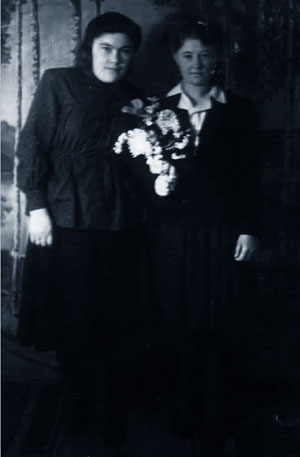
Irma Nau, Paulina Gerb-Sommer. Ananinsk 1950
Agapitovo
Settlement. 15 kms away from the settlement of Ust-Khantaika, nearer to Igarka. According to statements of special settlers about 500 of them were deported to this place in 1942 and soon-after were simply forgotten – almost all of them died. L.O. Petri’s book “The Germans from the Taimyr Area” tells about the tragedy of these people, who were deported to this part of the country during the war.
Bay in the northeastern part of the Taimyr Area, west of the Faddeya Bay; was part of the “constellation” of many small camps. Ships used to head for this bay, in order to supply „the fisherman“ with cargo. From the landing place up to where “the fisherman” lived, they built a road of about hundred kilometers in length, fit for tractor traffic. A few huts were build along this road, which ran from the Bay of Simovochnaya in a southwest direction, crossed the river Peka and continued along the Dorozhnaya (this is probably where its name comes from) and Shirokaya rivers.
Situated 100 kms away from Dickson. The special settlers used to catch fish, particularly white whales.
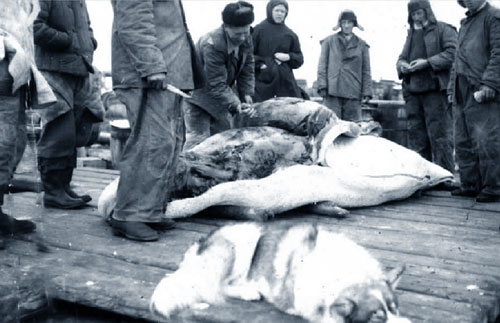
Cutting up of a white whale at Barkusino fishing station. 1949-1951.
In the centre – Maria Beis.
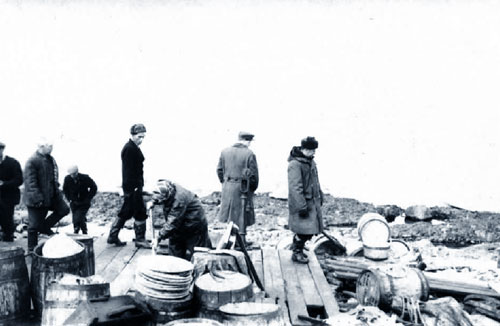
Barkusino fishing station, 100 kms away from the Dickson Island. 1949-1951.
Weighing of casks containing whale meat. The casks were delivered to fur farms
in the
immediate vicinities.
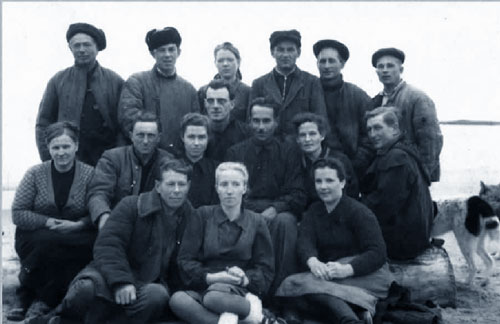
Special settlers working for the fishing industry at Barkusino fishing
station
on the lower reaches of the Yenisey. 1949-1951
In the centre – Andrei Stern, 1st row, 2nd from the left – Maria Prinz,
3rd row, 3rd from the left – Maria Beis
Old Russian place of hibernation situated on the right banks of the Yeniseysk
bay with
rich fishing grounds - from time immemorial. Special settlers were working
here during the war.
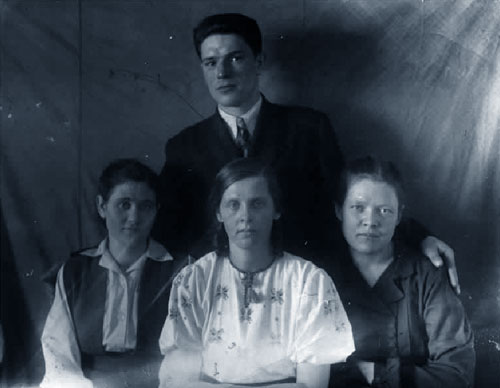
Settlement of Golchikha, Ust-Yeniseysk District. Early in the 1950s.
On the right: Maria Beis, who was working for the incoming fish department.
At the times of the Tsar the big village of Dudinka was a place of exile for political prisoners. As from 1935, when they began to built the Norilsk Combine, Dudinka became the subsidiary of the Norilsk corrective labour camp, which was at the same time responsible for the construction of the iron and steel combine, the laying of tracks for the planned railroad and the building of the port of Dudinka. From1935 till 1956 there were several forced labour camp sub-sectors of the Norilsk corrective labour camp in Dudinka. The biggest sub-sector, the 4th, was right in the centre of Dudinka.

Port of Dudinka. 1930s-1940s.
According to the memoirs of N.A. Odintsov, there were watch-towers at every corner of the camp zone: two of them paralleled the riverbanks of the Dudinka river, two more of them to both sides of the big village of Dudinka. One of them stood right in the place of today’s pump station, one not far from the trade centre. The other two watch-towers stood at a distance of about 600-750 meters from the riverbank – one of them on the right banks of the Aromatniy Brook, the second one at the inner face of today’s Yenisey“ store. All four sides were surrounded by three rows of barbed-wire fences (it would have been quite easy to run away, but nobody ever tried to do that – where could they have run to?). Prisoners had a wonderful view through the fence to everything that happened in freedom, while the inhabitants of Dudinka got some insight into the life of the inmates.

Construction of the narrow-gorge railway Dudinka-Norilsk. 1935-36.
Every now and then they would exchange a few words. The front part of the camp was facing towards the mouth of the river Dudinka, where you could see the landing points (all made of beams) on the right riverbank. In the southeastern part of the town (in the place of the 5th microdistrict) there was the camp cemetery.
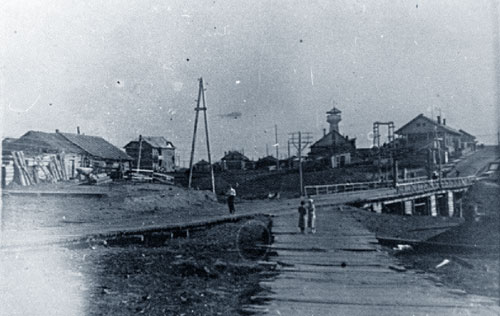
Sovetskaya street in the 1940s
Settlement in the Ust-Yeniseysk District, on the right bank of the river Yenisey, 300 kms away from Dickson. In 1942, during the time when the waters were navigable, 360 individuals were taken to this place. Most of them were unable to find themselves a job – there was no labour to be done. Towards the winter the special settlers began to build themselves log huts. They slept on three-tier bed boards. In November 1942 the famous Lett artist Herta Wulff, the mother of Gunar Kroders, the Taimyr journalist and author of memoirs “Live and recall”, died in Dorofeevsk. Here was the big fishing station attached to the Oshmarino, later Ust-Port fish factory. In Dorofeevsk pepople organized a surface cold storage room. The settlement has been abandoned since long, the surrounding area has grown wild.

Settlement Dorofeevsk, Ust-Yeniseysker District.1947-48.
From left to right: Maria und Andrei Schefer, in the centre – Maria Beis und
Maria Prinz

Settlement Dorofeevsk.1947-48.
Transportation by means of dog sledges.From left to right – Maria Beis, Ivan
Kraulis.
Settlement on the left bank of the Yenisey, on its lower reaches. In this place Lett special settlers organized the “Polar star” kolkhoz in 1942. Later, the kolkhoz shut down, and the settlement served as fishing station of commercial fishery of the State fish gactory in Ust-Port. In Innokentyevsk they organized a surface cold storage room for fish. The very last residents left the settlement in the late 1970s / early 1980s of the past century.
Settlement in the Ust-Yeniseysk District, situated 45 kms away from the settlement of Ust-Port, downstream the river Yenisey. In 1943 German special settlers organized the „Gardist“ kolkhoz in this place, headed by L.L.Loch. In 1959 W.A. Sabelfeld became the chairman of this economy.

Special settlers in the settlement of Kazantsevo, Ust-Yeniseysker District.
30.08.1947
"In eternal commemoration of the north. Lisa! One day we will recall our life in
the remote north. Dora“
(from Maria Smirnova’s (Beis) personal archives.
Kalargon – one of the camp sub-sectors of the Norillag. There was a prison, where inmates served their setences. Ruins of the prison building can be seen till this day.

Kalargon. 1988

Entrance to a punishment cell. Kalargon. 1988

Cell for „walks“. 1988

Kalargon. 1988
Settlement in the Khatanga District on the banks of Koshevnikovo Bay, where, in 1936, people began to win coal and drill for oil; appearance of pits and mines.
Old commercial centre on the lower reaches of the Yenisey, administrative centre of the Ust-Yeniseysk District. Place of resettlement of special settlers, who were working for the „New Way“ kolkhoz, during the war.
Fishing ground on the lower reaches of the Yenisey (right riverbank), where special settlers, who had been deported to this place during the war, were engaged in commercial fishery, a Anna Friedrichovna Ausinsch and her son Arthur and others. The special settlers then transported the entire catch to the settlement of Ust-Port – to the fish cannery.

Special settlers in the 1950s.
Fishing station in the Ust-Yeniseysk District, on the lower reaches of the Yenisey. They built the Oshmarino fish factory in this place in 1942, which was subordinated to the fish cannery in Ust-Port as fishing area. In June 1942 a party of special settlers was abandonded here. The settlement became extinct in the course of time and grew wild.

Special settlers fishing, 1950s
Fishing settlement on the right banks of the Yenisey, not far from Dudinka. „Fishermen“ from among so-called special settlers deported Volga-Germans, Finns) used to work here during the war.

Brigade of fishing special settlers. Levinskiye Peski. 1950s

Caught a fish. Settlement of Levinskiye Peski. 1950s
Cape on the left banks of Yenisey Bay. In 1943 the Leskino fish factory was built in this place with the objective of a maximum yield of fish in the Ust-Yeniseysk District and the fulfillment of the planned fish quota. A special contingent of special settlers from among deported peoples of the former USSR were working here.

Special settlers in the Ust-Yeniseysk District. 1950s.
Reloading point between the settlements of Polikarpovsk and Karaul in the Ust-Yeniseysk District. Here the people could take a rest, feed and water the horses.

Fishermen (special settlers). Cape Muksuninskiy. 1950s.
One of the most northern "Islands" of the GULAG Archipelago (Khatanga District). In 1937 prisoners built a road (70 kms in length) by means of pickaxes and spades, which connected the settlements of Nordvik and Koshevnikovo. During the war prisoners were winning coal and drilling for oil in this place. Apart from this there were general construction activities in the area.
Fishing point on the lower reaches of the Yenisey. Place of exile and work place for special settlers in the 1940s-1950s.

Fishing point Nikandrovsk on the lower reaches of the Yenisey.
Left – Lida Miller, next to her, with the white headscarf – Amalie Foos.
1940s-1950s.
Industrial centre to the north of the Khatanga District in the 1930s-1950s – about 500 kms away from Khatanga, where they explored industrial finding places of salt, oil and coal. In order to win all these mineral resources they brought into being the „Nordwikstroi“ Trust in 1936. B.V. Lavrov, who later became a victim of repressions, was appointed head of this organization. In Nordvik they used the manpower of prisoners, so that there is good reason to believe that this enterprise was part of the GULAG system. Prisoners built a port, bunkered fuel and freshwater for the ships, which were navigating on the Arctic Ocean, they were winning coal, oil and rock-salt.

Nordvik. First drilling for oil in the Arctic. 1935

Nordvik. Drilling tower. 17.10.1935
The industrial development in Nordvik, which had started with such an enormous swing was brought to a standstill in the middle of the 1950s, for they had not discovered any mineral-oil reservoirs that were big enough to start industrial processing, and the rock-salt turned out to be just an addition to gypsum.

Nordvik cemetery. 1989.

Nordvik cemetery. 1989.
Old settlement in the Ust-Yeniseysk District on the banks of the river Ushakov tributary (exactly ion the place where it flows into the Yenisey. This is almost the 17th parallel of latitude. In the 1940s –1950s Nosok became the residence of special settlers, mainly Volga-Germans. Among them there were a number of families quite well-known in the Taimyr Area: the Giss’ (Hiss) and the Felkers. Christian Christianovitch Giss was the very fist Taimyr German, who was made an honorary citizen of the Taimyr Region (1994). He was holding the position of a deputy chairman of the „Taimyr Aurora” kolkhoz for many years. The centre of this kolkhoz was situated right in the settlement of Nosok.

The children of special settlers. Ust-Yeniseysk District. 1950s
Settlement in the Ust-Yeniseysk District on the lower reaches of the Yenisey (left riverbank). During the war the Oshmarino fish factory was put into operation in this place. The people working for the cannery. Pilots of the Igarka port authorities were stationed in this place, too. The settlement was later abandoned.

Special settlers in Oshmarino, Ust-Yeniseysk District. 1946.
Settlement in the Ust-Yeniseys District, center of the "Red man from Taimyr“ kolkhoz, which was founded in 1929 as a Russian kolkhoz. During the war special settlers were working for this kolkhoz: Letts, Estonians, Germans. N.A. Tolstikhin was appointed its chairman, deputy chairman - A.J. Brait, book-keeper O.P. Bojars.
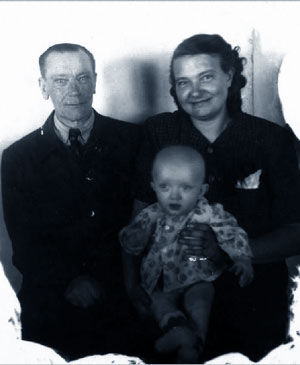
Members of the deported Finnish Puss family. Polikarpovsk 1950s.

Residents of the settlement of Polikarpovsk. 1950s.

Nestor Aleksandrovich Tolstikhin with his wife Aleksandra Arkhipovna
and son Viktor. 1952

Nestor Aleksandrovich Tolstikhin with his wife Aleksandra Arkhipovna
and son Viktor. 1959
Old trading centre situated on the river Yenisey; the old-established Russian
famililies of the Ivanova and Mirgunovs lived here in the 19th century.
In the summer of 1942 a special contingent was delivered to this place: families
of deported Soviet Germans and Letts.

D.A. Losev – commander of the settlement of Potapovo. 1951

Milja Deigraf, Erika Koch, Theresa Pabst, Ella Preister, Ella Stol.
Settlement of Potapovo. At the brook. 1950s
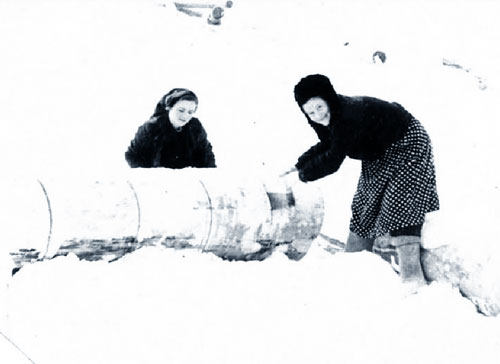
Supplying firewood for the settlement of Potapovo.
On the right side – Lydia Koch. 1957.

Luisa Karlovna Koch with her children: Erik, Vladimir and Lydia.
Settlement of Potapovo. 1940s
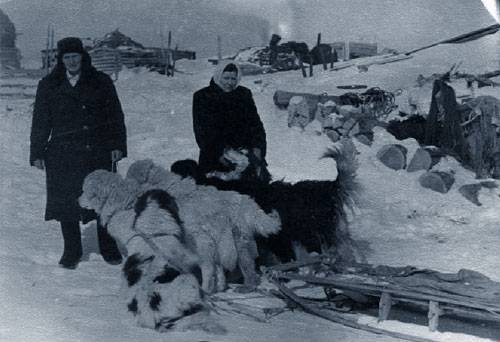
J.A. Ekkert with her husband A.I. Slepkov. Settlement of Potapovo, 1960s
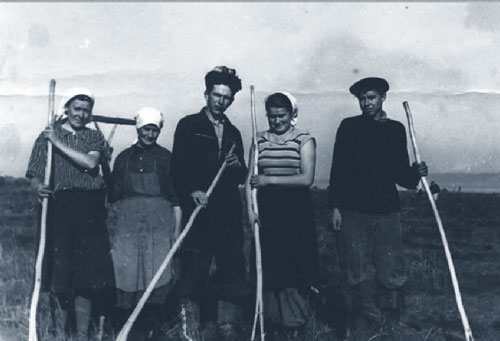
Yekaterina Ekkert, Maria Preister with her daughter Yevgenia during the hay
harvest.
Potapovo 1950s
Centre of the „constellation“ of smaller camps, which were operationg in the northeastern part of the Taimyr Peninsula in conection with the carrying out of tasks with geological background and character. ("Contact" – nowadays you can still see the remainders of beams on the banks of the river Goltsova south of the mouth of the Shirokaya river. We als o have „Lake Moskovskoe" in this place, on the left banks of the Leningradskya river – here they used to win coal for the “fisherman’s” needs. Another place is "Zaosyornaya" situated on a river of the same name, on the left tributary of the river Leningradskaya; here we can still see the remainders and ruins (apart from beams) of a shed-like building with different kinds of products and clothings. In this place they prospected for minerals and carried out geological research).

Rybak camp 2005. Photo: Vladimir Andronov

Rybak camp 2005. Photo: Vladimir Andronov

Rybak camp 2005. Photo: Vladimir Andronov
Settlement in the Ust-Yeniseysk District. During the war exiled calmucks
organized
a fishing kolkhoz called “4th five-year plan” in this place.

Volga-Germans on the lower reaches of the Yenisey. Sidorovsk, 1950s.
From left to right: Amalia Foos (Wais). The names of the other people are not
known.
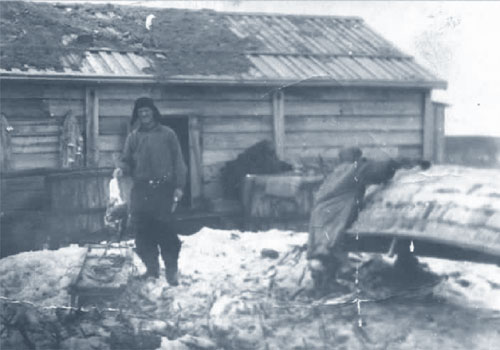
Settlement of Sidorovsk, where the Wais’ were working: David Davidovich and
Amalie Yakovlevna in the 1940s-50s.
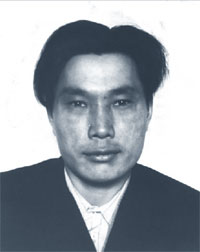
Andreji Zebekovich Erdinev. 1957.
Born on the hamlet of Kamyshevo, Limansk District, Astrakhan Region.
Settlement situated in the Dudinka District, place of exile for special settlers during the war.
The special resettlers used to send all fish they had caught in Sitkovo to the fish factory in Dudinka, to the settlement of Pshenichniy Ruchey.
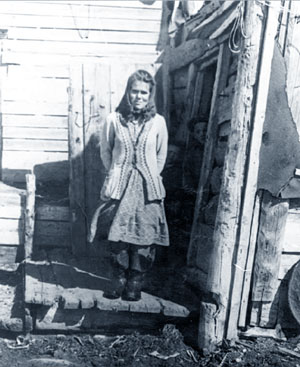
Luisa Yegorovna Root. 1950s.
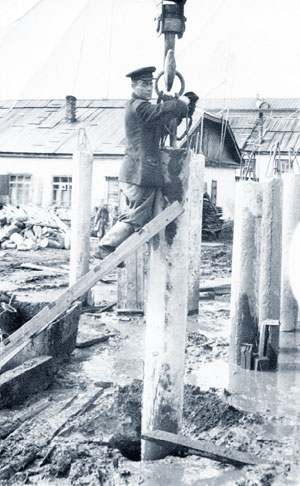
Alexander Kondratevich Scherer. 1950s.

Dwelling house in the settlement of Pshenichniy Ruchey. 1950s
Settlement to the north of the Khatanga District, where prisoners were forced to produce rock-salt in the1930s – 1950s. The settlement was abandonded in the 1950s.

Solerudnik. S.N. Morosov. 1990

Railroad to Solerudnik. S.N. Morosov. 1990
Trading post on the right banks of the Yenswy. In the spring of 1943 they deported special settlers from Dorofeevka, who had managed to survive the first winter, to this place.

Receipt of fish 1956-1957
Very old village on the right banks of the Yensiey, on his lower reaches; at the
times of the Tsar this was a place where political prisoners were exiled to.
Here is the grave of the exiled clergyman Pimen, who was deported to Tolstyi Nos
in the 18th century.
During the war special settlers were deported to this place; they had to work
for the Tolstonovsk fish factory. The average number of workers was 400. They
produced about 5000 hundredweights of valuablefillets of fish Fisch as well as
canned fish products; the factory existed from 1943 till 1947.

Semjyn und Lydia Gesselson - exiled Volga-Germans
in the village of Tolstyi Nos, 1956-1957

Special settlers. Workers of the Tolstonosovsk fish factory Fischfabrik. 1943
Settlement in the Ust-Yeniseysk District. Historical records have been existing since 1916, when they started to build the port of transshipment on the lower reaches of the Yenisey.
I.I. Lid, a Norwegian entrepreneur and director of a Siberian company, called this place Ust-Yeniseysk. The project to build a port in Ust-Yeniseysk was realized by the talented engineer A.M. Wichman (authour of the port project in Odessa).
The primary transshipment capacity of the port was supposed to amount to 300 000 tons per year. In order to guarantee a profitably efficiency of the port, I.I. Lid additionally built a fish factory in this place, whereby he organized the complete appointments and equipment to be delivered from Norway. Labour resettlers worked for this factory in the 1920s and 1930s, so-called dispossessed big (rich) farmers. During the war the factory in Ust-Port used to mainly employ special settlers – Soviet Germans, Calmucks, people from the Baltic states, representatives of deported peoples. Ust-Port disposed of its own fihing fleet, three motorboats called „Nordvik“, „Khatanga“ und Burnyi“.

Fish cannery in Ust-Port in the 1950s

Workers of the Ust-Port fish cannery.
Settlement of Ust-Port. 1958.
In the centre (on the cart): Peter Filbert, next to him Elsats Badmaeva,
Dorothea Kalmaewa.

Unloading fish in Ust-Port. Second from the left - Sofia, Khalga Sangadzieva
(Calmuck)
Warya Limanis (Lett), Ivan Genz (brigade leader)

Unloading finished products. Ust-Port fish cannery.

Unloading of salt from Krasnoyarsk for the fish cannery. Ust-Port 1942

Workers of the finished products’ store-room in the Ust-Port fish factory.
Ust-Port. 1957-1958.
Situated on the right banks of the river Yenisey, a little north to theplace, where the river Khantaika joins the Yenisey. In 1942 about 450 special settlers were deported to this place, who, according to the memoirs of Brigitta Wakker, were accomodated in attics, junk and lumber rooms or in tents pitched on the banks of the Yenisey. The special settlers organized a German kolkhoz named „Northern passage“. It was the most southern settlement in the Dudinka district; nonetheless, the death rate among the sepcial settlers living in this place was the highest of all: the people died from diseases, hunger and harsh climate.

Memorial built up on the riverbank in Ust-Khantajka
in the summer of 2005

Maria Yakovlevna Scherer with her daughter Irma
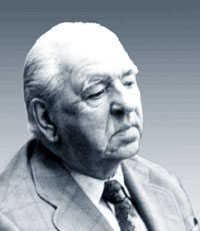 Old hamlet, founded in 1926. Administrative centre of the Khatanga District. In
the 1940s-1950s Khantaga became a place of exile for Soviet Germans, Letts and
Lithuanians, who suffered from repressions. Gunar Kroders, who came from Latvia,
served his sentence as an exile in Khatanga, too. He was a famous journalist of
the TaimyrRegion.
Old hamlet, founded in 1926. Administrative centre of the Khatanga District. In
the 1940s-1950s Khantaga became a place of exile for Soviet Germans, Letts and
Lithuanians, who suffered from repressions. Gunar Kroders, who came from Latvia,
served his sentence as an exile in Khatanga, too. He was a famous journalist of
the TaimyrRegion.

Settlement of Khatanga. 1940s
Fishing area in the Ust-Yeniseysk District, north of the Nosonovsk Islands (right riverbank). Here they had the „Unresting Labourer“ kolhkoz „Rastloser Arbeiter“ („Truzhenik“). During the war special settlers were deported to this place in the Taimyr Region in order to work for the fishing industry.
...I, Olga Matveevna Oinas – Finn, was born in the KingisepskDistrict, Leningrad Region. As from 1943 until 1946 I worked as a fisherwoman for the „Truzhenik“ kolkhoz in Yakovlevskaya Kosa. In our fishing area there lived Germans from the Volga, Letts and Calmusks. The chairman of our kolkhoz was the wounded front-line soldier Mandzhiev, Yelizaveta Matweevna Vasileva fulfilled the functions of a party organizer. From among the Letts I still recall the family names of Teltenbrenz and Reiter (Reuter?), and I also remember the German surname Frank. Being of Finnish origin they mobilized me to the remote north, to the district centre of Karaul, by force. The two branches of our kolkhoz, however, were situated in Yakovlevskaya Kosa and in Nosonowsk. In 1946 I removed to Dudinka to live with my mother Yelena Fominichna Nousikainen.
(from a letter kept with the regional archive, 1990.)
Taimyr Regional Museum of Local Lore
Fund for cultural initiatives
(Mikhail-Prokhorov-Foundation)
2006